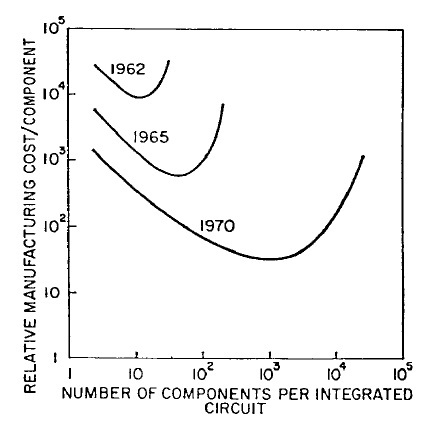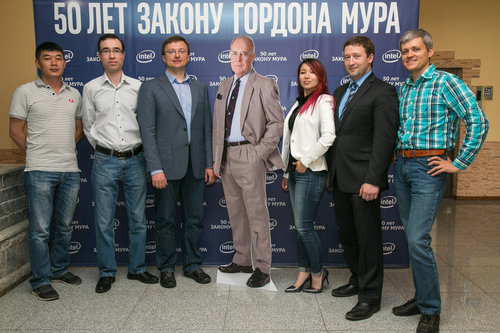A new study by the Association of the semiconductor industry: "After 5 years, Moore's law will cease to operate"

Image : Rebecca Mock
Moore's law has been known to the general public for over 50 years. Not being a law in the narrow sense of the word, for decades it generally remained fair. Although there are doubts about what was primary: the law or the desire of the world's largest corporations, which set the tone for the entire IT industry, to follow it.
From time to time, experts predict that the law will cease to operate. However, this was not previously confirmed in practice. But this time everything is more serious. At least, the Semiconductor Industry Association thinks so.
On April 19, 1965, in the magazine Electronics under the heading "Experts Looking to the Future", the now famous article by Gordon Moore entitled "Cramming more components not integrated circuits" was published. In this article, Moore (the future co-founder of Intel Corporation), then working as a director of development at Fairchild Semiconductors, gave a forecast for the development of microelectronics for the next ten years based on an analysis of six years of microelectronics development, predicting that the number of elements on electronic chips will continue to double each year. .
Subsequently, the name “Moore's Law” stuck with this forecast. And, ironically, this empirical observation became the most famous law in the IT industry and the semiconductor industry. Moreover, for many microprocessor developers this has become a guide to action.
')

On the basis of Moore's law, no rigorous physical or mathematical models were constructed reflecting the exponential nature of the development of the industry. Therefore, the law remained largely sociological, "engineering". However, the concept itself turned out to be convenient for describing and forecasting the development of companies - especially from the point of view of marketing specialists and directors of microelectronic enterprises. Production plans and pricing lined up based on Moore's law.
The original article in 1965 was written at a time when no Intel company existed yet, and its future founders were looking for ideas for their business. In particular, the driving force capable of making electronics truly mass. And the main obstacle for this was, first of all, the price.
Accordingly, the initial observation consisted in how the cost of a single transistor behaves, depending on their quantity and production technology.

The user " Habrakhabra " yurav in his article comments on this chart like this:
For small (by the standards of a specific technology) devices, the cost of a transistor is almost inversely proportional to their number. But, with an increase in the number of transistors, the crystal area grows, the share of the yield of usable crystals during production decreases and, accordingly, the price increases.
It turns out that for each production technology there is a certain level of device complexity (expressed by the number of transistors in their composition), for which the use of this technology is most beneficial. The transition to the new process technology is achievable when the cost of the transistor at the new design rate is significantly lower than for the current technology. Here a forecast was made about a tenfold reduction in the cost of the transistor when changing the process technology.
Later, many other interpretations of Moore's law appeared:
• the most advantageous number of transistors on a chip doubles each year;
• the number of transistors in manufactured chips doubles every two years;
• technologically possible number of transistors on a microprocessor chip doubles every two years;
• microprocessor performance doubles every 18 months;
• microprocessor clock frequency doubles every 18 months;
• computer computing power doubles every 18 months;
• available computing power doubles every 18 months;
• the density of transistors on a chip doubles every 18 months;
• computing power available for $ 1 doubles every 18 months;
• The cost of a chip drops twice every 18 months.

Image from article.techlabs.by
Of course, for 50 years there have been all sorts of deviations: more complex and simpler chips have always coexisted. This is a general trend, so to speak mainstream. To this, of course, put a hand to Intel, which personifies this mainstream. At least he tries hard.
But she also rested in purely physical limitations that no longer allow the fulfillment of the conditions of Moore's law. According to the Association of Semiconductor Industry, this time everything is serious.
Association experts predict that in 5 years transistors will not be able to decrease. Chip developers are already looking for a way out of this situation. But in any case, it will require a significant increase in costs, at least at first.
One of the alternatives is the production of 3D chips: vertical arrangement of the processor cores relative to each other instead of the current horizontal one. However, in this case, the developers will face another problem - overheating. Chips heat up much more intensively, and liquid cooling in this case is an inevitable attribute. The first Aquasaur supercomputer has already been built on 3D chips, and if it had been equipped with a traditional "fan", its processor would simply melt.
The use of 3D technology has reduced the time to transfer data between the transistor and memory, as a result of which the chip architecture can perform lightning-fast calculations a thousand times faster than previously possible.

Experts from the Association of the semiconductor industry suggest that over the next 5 years, manufacturers will not find a way to increase speed and reduce costs in accordance with Moore's law. But they do not deny that computers will cease to be improved by some other parameters.
“The Boeing 787 was not faster than the 707 was in 1950, but these are two different aircraft. Innovations will definitely be introduced, but they will be more subtle and complex, ”says Daniel Reed, vice president of research at the University of Iowa.
Here's what other experts think about the prospects for Moore’s law:

Alexander Lyamin, SEO QRATOR
1. Does Moore's law exist objectively? Or is this a tacit agreement between manufacturers?
Moore's Law is an entertaining empirical observation. It works only in a certain set of technologies - and, as a result, within certain limits (above and below). By the way, very similar to the Nagle algorithm.
2. What are the alternatives that allow you to further reduce costs and increase productivity?
Accordingly, the change of technology changes either the boundaries or altogether abolishes the “law”, because, in fact, this is an empirical observation.
3. 3D-chips: vertical arrangement of processor cores relative to each other instead of the current horizontal one. This simple focus, by reducing the distance between the cores, will increase the data transfer rate between them several times. How promising is this solution? Can it extend the life of Moore's law?
3D chips - yes. I have a childhood dream like that. See what www.tilera.com Tilera did (and now EZChip, and if absolutely now - Mellanox) 5 years ago! And imagine that the density of connections has increased by a degree.
4. "The number of people predicting the death of Moore's law doubles every two years." Comment, please. What is the truth in this statement?
For we know in part, and in part we prophesy ...

Artyom Subbotin , CEO Terminal Solutions LLC
1. Does Moore's law exist objectively? Or is this a tacit agreement between manufacturers?
It is difficult to look under the carpet of the corporation and in the heads of the people working in them. But my personal opinion is that 18 months for “doubling of capacity” is a production period for the release of a new product. It's damn convenient when a whole army of consumers, every two years, are looking forward to "twice the fast processor" and with indignation look at the old and very slow stone, bought for big money last Christmas.
2. What are the alternatives that allow you to further reduce costs and increase productivity?
I think the next step is to translate everything into pure marketing, like, for example, Apple did: “we added a new convex lens and now the violets in the photos look even more purple”. Already very few people are interested in how many real operations a processor does per second; it is all important what kind of game it plays or how silent it is.
4. "The number of people predicting the death of Moore's law doubles every two years." Comment, please. What is the truth in this statement?
You can still say so: "every person who doubted Moore's law will surely die (sometime)."
The experts of “Toaster” answered another question: “Does the observance of Moore's law signify the reality of super-clearing calculations?”
Riateche Riateche :
Not. If Moore's law continues to be executed, the number of operations performed by the machine per unit of time will increase. But it will remain finite. More precisely, it will become infinite in infinite time, and this does not suit us.
Monnoroch Monnoroch :
I understand you came to this conclusion from the fact about the converging series on Wikipedia? To be more exact, from the fact that power doubles, and power * time = number of calculations => with doubled power, is the number of calculations (unsuccessful, but oh well) in half the shortest time?
There are a few problems here. Well, first of all, calculations are not infinitely divisible, and half of the “calculations” is the same as the zero of “calculations”. And secondly, the logic is wrong in itself. After all, look: today is X, tomorrow the power has increased 2 times - 2X, then 4X. Well, yes, sum up, get infinity. But only if we sum up to infinity - and this is infinite time.
kyrie kyrie :
I do not think that the number of transistors will somehow affect the fundamentals.
PS Some experts believe that Moore's law is not fulfilled with an accuracy sufficient to consider it not only a law, but also an empirical dependence. It is possible that the hype around Moore's law is a clever marketing move by Intel. But one way or another, this law was taken up by everyone and fell in love with computer people.
Many scientists believe that Moore's law became popular because in a simple and very accessible form it determined the fantastic rates of development of the semiconductor industry at that time.
Already by 2003, Gordon Moore calculated that the number of transistors delivered annually to the market in the world reached 10,000,000,000,000,000 (10 to the power of 19). This is a hundred times more than the number of all the ants on Earth.
Source: https://habr.com/ru/post/307158/
All Articles